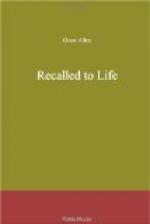As I went on, I began to learn more and more about my father. He had made money in Australia, it was said, and had come to live at Woodbury some fourteen years earlier, where my mother had died when I was a child of four; and some accounts said she was a widow of fortune. My father had been interested in chemistry and photography, it seemed, and had lately completed a new invention, the acmegraph, for taking successive photographs at measured intervals of so many seconds by electric light. He was a grave, stern man, the papers said, more feared than loved by his servants and neighbours; but nobody about was known to have a personal grudge against him. On the contrary, he lived at peace with all men. The motive for the murder remained to the end a complete mystery.
On the second morning of the inquest, however, a curious thing happened. The police, it appeared, had sealed up the room where the murder took place, and allowed nobody to enter it till the inquiry was over. But after the jury came round to view the room, the policeman in charge found the window at the back of the house had been recently opened, and the box with the photographic apparatus had been stolen from the library. Till that moment nobody had attached any importance to the presence of this camera. It hadn’t even been opened and examined by the police, who had carefully noted everything else in the library. But as soon as the box was missed strange questions began to be asked and conjecturally answered. The police for the first time then observed that though it was half-past eight at night when the murder occurred, and the lamp was not lighted, the witnesses who burst first into the room described all they saw as if they had seen it clearly. They spoke of things as they would be seen in a very bright light, with absolute definiteness. This set up inquiry, and the result of the inquiry was to bring out the fact, which in the excitement of the moment had escaped the notice of all the servants, that as they entered the room and stared about at the murder, the electric flash of the apparatus was actually in operation. But the scene itself had diverted their attention from the minor matter of the light that showed it.
The Inspector had been watching me narrowly as I read these extracts. When I reached that point, he broke in with a word of explanation.
“Well, that put me on the track, you see,” he said, leaning forward once more. “I thought to myself, if the light was acting, then the whole apparatus must necessarily have been at work, and the scene as it took place must have been photographed, act by act and step by step, exactly as it happened. At the time the murderer, whoever he was, can’t have known the meaning of the flashes. But later, he must have come to learn in some way what the electric light meant, and must have realised, sooner than we did, that therein the box, in the form of six successive negatives of the stages in the crime, was the evidence




